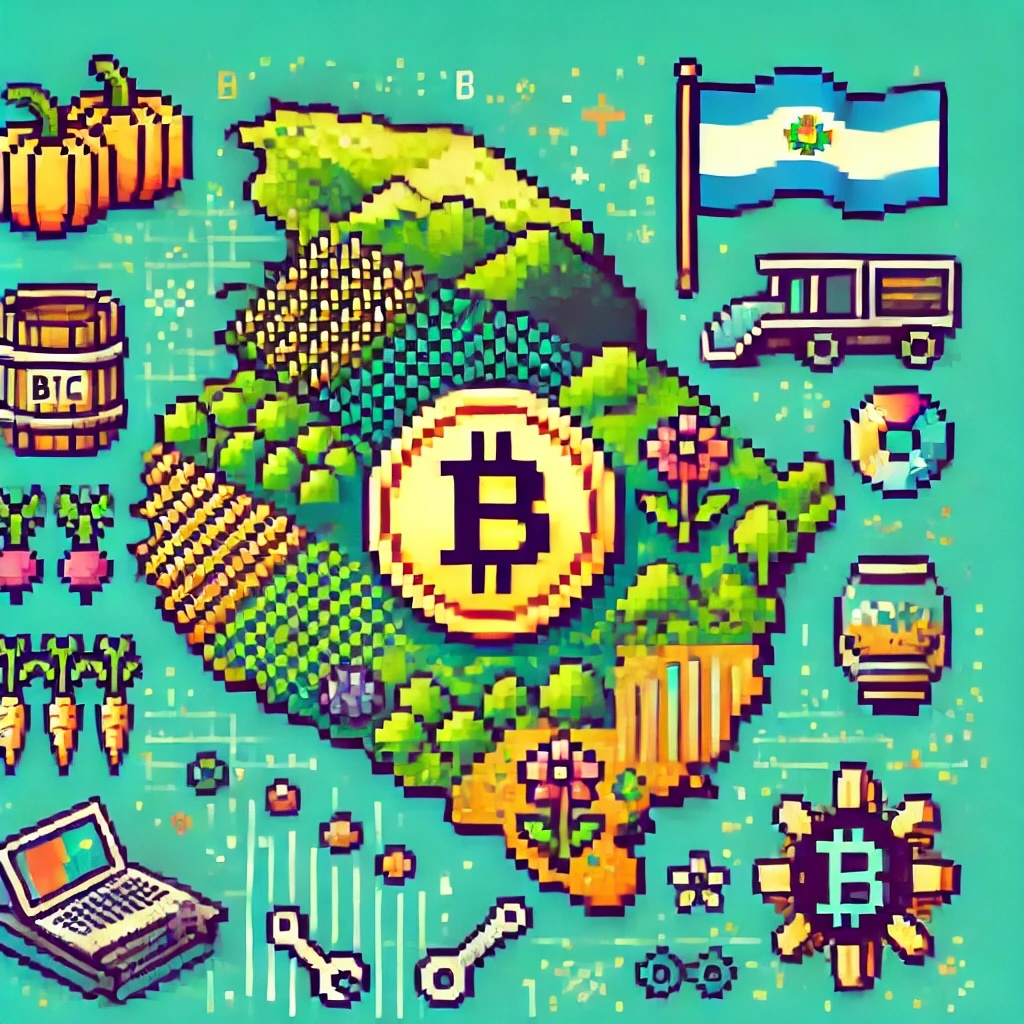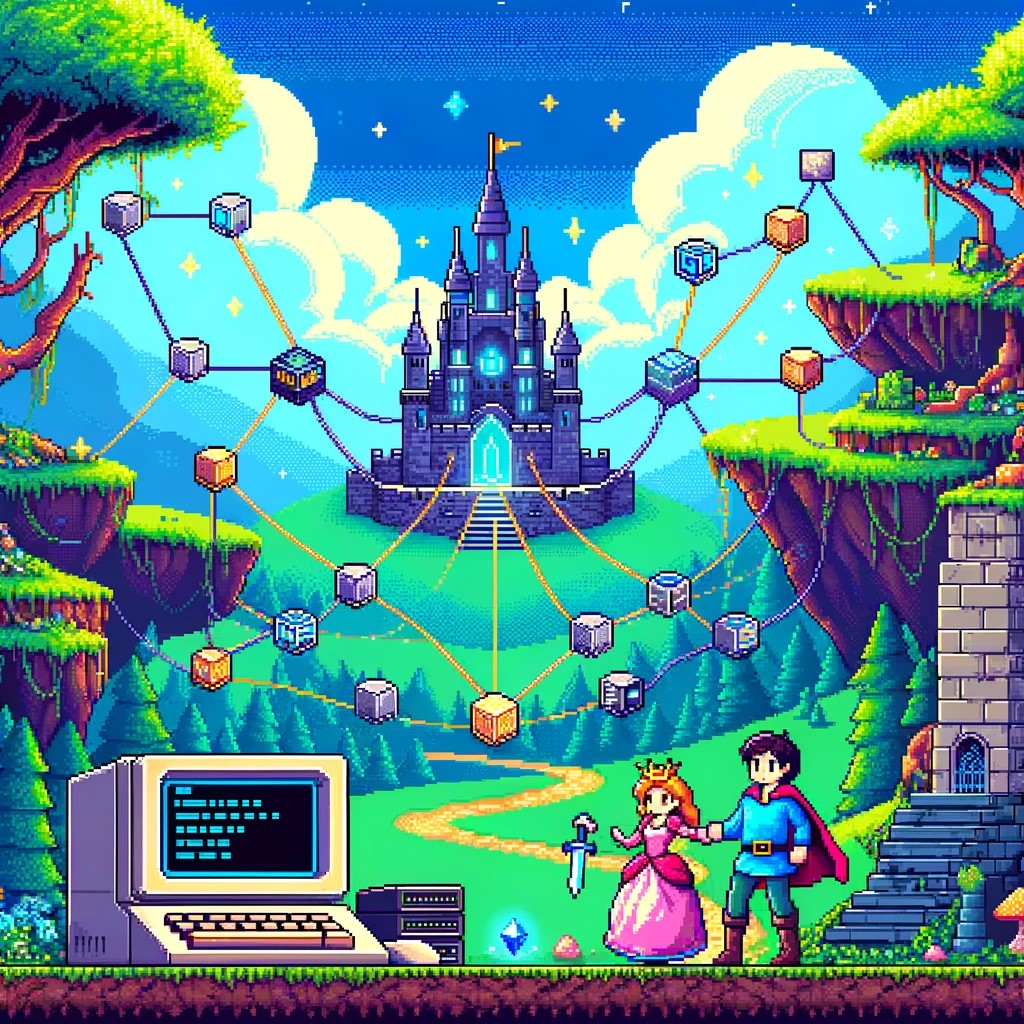
by Joche Ojeda | Jul 3, 2024 | A.I, Blockchain, El Salvador
El Salvador, my birthplace, has recently emerged as a focal point for technological innovation under the leadership of President Nayib Bukele. Born in Suchitoto during the civil war and now living as a digital nomad in Saint Petersburg, Russia, I have witnessed El Salvador’s transformation from a distance and feel compelled to share its story. This article is the first in a series exploring how blockchain technology, financial services, and artificial intelligence (AI) can help a small country like El Salvador grow.
Historical Context and Economic Challenges
El Salvador has faced significant economic challenges over the past few decades, including poverty, gang violence, and a heavy reliance on remittances from abroad. The economy has traditionally been rooted in agriculture, with coffee and sugar being key exports. However, President Bukele, who took office on June 1, 2019, has sought to address these challenges by diversifying the economy and embracing technology as a key driver of growth.
Bukele’s Vision for Economic Transformation
President Bukele’s administration has prioritized technological innovation as a catalyst for economic transformation. His vision is to modernize the country’s infrastructure and position El Salvador as a hub for technological innovation in Latin America. This vision includes the strategic shift from an agriculture-based economy to one focused on technology, financial services, and tourism. The goal is to create a more resilient and diverse economic base that can sustain long-term growth and development.
The Adoption of Bitcoin as Legal Tender
One of the most groundbreaking moves by Bukele’s administration was the introduction of the Bitcoin Law, passed by the Legislative Assembly on June 9, 2021. This law made Bitcoin legal tender alongside the US dollar, which had been the country’s official currency since 2001. The rationale behind this decision was multifaceted:
- Financial Inclusion: With a significant portion of the population lacking access to traditional banking services, Bitcoin offers an alternative means of financial inclusion.
- Reduction in Remittance Costs: Remittances make up a substantial part of El Salvador’s economy. Bitcoin’s adoption aims to reduce the high transaction fees associated with remittance services.
- Economic Innovation: By adopting Bitcoin, El Salvador aims to attract foreign investment and position itself as a leader in cryptocurrency and blockchain technology.
The implementation of Bitcoin involved launching the Chivo Wallet, a state-sponsored digital wallet designed to facilitate Bitcoin transactions. The government also incentivized adoption by offering $30 worth of Bitcoin to citizens who registered for the wallet.
Initial Reactions and Impact
The reaction to the Bitcoin Law was mixed. While some praised the move as innovative and forward-thinking, others raised concerns about the volatility of Bitcoin and its potential impact on the economy. Despite these concerns, the Bukele administration has remained committed to its Bitcoin strategy, continuing to invest in Bitcoin and integrate it into the national economy.
Digital Transformation Initiatives
I
n addition to Bitcoin adoption, El Salvador has partnered with global tech giants like Google to enhance its digital infrastructure. These partnerships aim to modernize government services, improve healthcare through telemedicine platforms, and revolutionize education by integrating AI-driven tools. For instance, Google’s collaboration with the Salvadoran government includes training government agencies on cloud technologies and developing platforms that allow interoperability between institutions.
Strategic Shift to Technology, Financial Services, and Tourism
President Bukele’s broader economic strategy involves shifting El Salvador’s economic focus from traditional agriculture to more dynamic and sustainable sectors like technology, financial services, and tourism. This shift aims to create high-value jobs, attract foreign investment, and build a more diversified economy.
- Technology: By investing in digital infrastructure and fostering a favorable environment for tech startups, El Salvador aims to become a regional tech hub.
- Financial Services: The adoption of Bitcoin and other fintech innovations is intended to transform the financial landscape, making it more inclusive and efficient.
- Tourism: Enhancing the country’s tourism sector, with initiatives to promote its natural beauty and cultural heritage, is another key pillar of Bukele’s economic strategy.
Conclusion and Future Prospects
El Salvador’s journey towards becoming a technological leader in Latin America is a testament to the transformative power of visionary leadership and innovative policies. Under President Bukele, the country has taken bold steps to embrace technology, from adopting Bitcoin to integrating AI into public services. This series of articles will delve deeper into these initiatives, exploring their impact, challenges, and the future prospects for El Salvador in the global technological landscape.
By understanding El Salvador’s technological revolution, we can gain insights into the potential for other nations to leverage technology for economic and social development. The next article in this series will focus on the detailed implementation of Bitcoin as legal tender, examining the steps taken by the Bukele administration and the outcomes observed so far.
This introductory article sets the stage for a comprehensive exploration of El Salvador’s technological transformation under President Bukele. The subsequent articles will provide in-depth analyses and propose potential AI legislation to ensure the country’s continued leadership in technology within Latin America.

by Joche Ojeda | Jun 11, 2024 | Uncategorized
Getting Started with Stratis Blockchain Development: Running Your First Stratis Node
Stratis is a powerful and flexible blockchain development platform designed to enable businesses and developers to build, test, and deploy blockchain applications with ease. If you’re looking to start developing for the Stratis blockchain, the first crucial step is to run a Stratis node. This article will guide you through the process, providing a clear and concise roadmap to get your development journey underway.
Introduction to Stratis Blockchain
Stratis offers a blockchain-as-a-service (BaaS) platform, which simplifies the development, deployment, and maintenance of blockchain solutions. Built on a foundation of the C# programming language and the .NET framework, Stratis provides an accessible environment for developers familiar with these technologies. Key features of Stratis include smart contracts, sidechains, and full node capabilities, all designed to streamline blockchain development and integration.
Why Run a Stratis Node?
Running a Stratis node is essential for several reasons:
- Network Participation: Nodes form the backbone of the blockchain network, validating and relaying transactions.
- Development and Testing: A local node provides a controlled environment for testing and debugging blockchain applications.
- Decentralization: By running a node, you contribute to the decentralization and security of the Stratis network.
Prerequisites
Before setting up a Stratis node, ensure you have the following:
- A computer with a modern operating system (Windows, macOS, or Linux).
- .NET Core SDK installed.
- Sufficient disk space (at least 10 GB) for the blockchain data.
- A stable internet connection.
Step-by-Step Guide to Running a Stratis Node
1. Install .NET Core SDK
First, install the .NET Core SDK, which is necessary to run the Stratis Full Node. You can download it from the official .NET Core website. Follow the installation instructions for your specific operating system. I recommend having all DotNetCore SDKs because the source code for most of the Stratis solutions target really an old framework version like.NET Core 2.1 so it’s better to have multiple choices of framework in case you need to re-target for compatibility
.NET Core Versions
- .NET Core 3.1 (LTS)
- .NET Core 3.0
- .NET Core 2.2
- .NET Core 2.1 (LTS)
- .NET Core 2.0
- .NET Core 1.1
- .NET Core 1.0
Installation Links
Download .NET Core SDKs
2. Clone the Stratis Full Node Repository
Next, clone the Stratis Full Node repository from GitHub. Open a terminal or command prompt and run the following command:
git clone https://github.com/stratisproject/StratisFullNode.git
This command will download the latest version of the Stratis Full Node source code to your local machine.
3. Build the Stratis Full Node
Navigate to the directory where you cloned the repository:
cd StratisFullNode
Now, build the Stratis Full Node using the .NET Core SDK:
dotnet build
This command compiles the source code and prepares it for execution.
4. Run the Stratis Full Node
Once the build process is complete, you can start the Stratis Full Node. Use the following command to run the node:
cd Stratis.StraxD
dotnet run -testnet
This will initiate the Stratis node, which will start synchronizing with the Stratis blockchain network.
5. Verify Node Synchronization
After starting the node, you need to ensure it is synchronizing correctly with the network. You can check the node’s status by visiting the Stratis Full Node’s API endpoint in your web browser:
http://localhost:37221/api
here is more information about the possible ports for the API depending on which network you want to use (test or main) and which command did you use to start up the API
Swagger
To run the API in a specific port you can use the following code
StraxTest (dotnet run -testnet -apiport=38221)
http://localhost:38221/Swagger/index.html
StraxTest
http://localhost:27103/Swagger
StraxMain
http://localhost:17103/Swagger
You should see a JSON response indicating the node’s current status, including its synchronization progress.
Conclusion
Congratulations! You have successfully set up and run your first Stratis node. This node forms the foundation for your development activities on the Stratis blockchain. With your node up and running, you can now explore the various features and capabilities of the Stratis platform, including deploying smart contracts, interacting with sidechains, and building blockchain applications.
As you continue your journey, remember that the Stratis community and its comprehensive documentation are valuable resources. Engage with other developers, seek guidance, and contribute to the growing ecosystem of Stratis-based solutions. Happy coding!
Previous articles
Discovering the Simplicity of C# in Blockchain Development with Stratis | Joche Ojeda

by Joche Ojeda | Jun 10, 2024 | Blockchain, C#, Smart contracts, Stratis
Introduction
Blockchain technology has revolutionized various industries by providing a decentralized and secure way to manage data and transactions. At the heart of this innovation are smart contracts—self-executing contracts with the terms directly written into code. My journey into blockchain development began with the excitement of these possibilities, but it also came with challenges, particularly with the Solidity programming language. However, everything changed when I discovered the Stratis platform, which supports smart contracts using C#, making development much more accessible for me. In this article, I’ll share my experiences, challenges, and the eventual breakthrough that came with Stratis.
Challenges with Solidity
Solidity is the most popular language for writing smart contracts on Ethereum, but it has a steep learning curve. My background in programming didn’t include a lot of JavaScript-like languages, so adapting to Solidity’s syntax and concepts was daunting. The process of writing, testing, and deploying smart contracts often felt cumbersome. Debugging was a particular pain point, with cryptic error messages and a lack of mature tooling compared to more established programming environments.
The complexity and frustration of dealing with these issues made me seek an alternative that could leverage my existing programming skills. I wanted a platform that was easier to work with and more aligned with languages I was already comfortable with. This search led me to discover Stratis.
Introduction to Stratis
Stratis is a blockchain development platform designed to meet the needs of enterprises and developers by offering a simpler and more efficient way to build blockchain solutions. What caught my attention was its support for C#—a language I was already proficient in. Stratis allows developers to create smart contracts using C#, integrating seamlessly with the .NET ecosystem.
This discovery was a game-changer for me. The prospect of using a familiar language in a robust development environment like Visual Studio, combined with the powerful features of Stratis, promised a much smoother and more productive development experience.
Why Stratis Stood Out
The primary benefit of using C# over Solidity is the familiarity and maturity of the development tools. With C#, I could leverage the rich ecosystem of libraries, tools, and frameworks available in the .NET environment. This not only sped up the development process but also reduced the time spent on debugging and testing.
Stratis offers a comprehensive suite of tools designed to simplify blockchain development. The Stratis Full Node, for instance, provides a fully functional blockchain node that can be easily integrated into existing applications. Additionally, Stratis offers a smart contract template for Visual Studio, making it straightforward to start building and deploying smart contracts.
Another significant advantage is the support and community around Stratis. The documentation is thorough, and the community is active, providing a wealth of resources and assistance for developers at all levels.
Conclusion
Transitioning from Solidity to Stratis was a pivotal moment in my blockchain development journey. The challenges I faced with Solidity were mitigated by the ease and familiarity of C#. Stratis provided a robust and efficient platform that significantly improved my development workflow.
In the next article, I will dive into the practical steps of setting up the Stratis development environment. We’ll cover everything you need to get started, from installing the necessary tools to configuring your first Stratis Full Node. Stay tuned for a detailed guide that will set the foundation for your journey into C# smart contract development.

by Joche Ojeda | Apr 16, 2024 | Blockchain
Understanding Ethereum and Smart Contracts
The Ethereum Virtual Machine (EVM) is akin to a global, decentralized computer that exists across thousands of individual computers worldwide. This “computer” executes programs known as smart contracts, which are automated contracts whose terms are written directly into code, allowing them to operate independently of intermediaries.
How Smart Contracts Work
Smart contracts streamline processes such as digital agreements and transactions. For example, in a leasing agreement, a smart contract can automate monthly rent payments from a tenant’s digital wallet to a landlord’s wallet, adhering to the terms with precision and reliability. This automation is set into motion through the following steps:
- Creation: A developer writes the contract in a specific programming language.
- Deployment: The contract is uploaded to the Ethereum blockchain.
- Execution: It is then executed automatically by the EVM upon being triggered by transactions.
Comparing Blockchain Platforms
While Ethereum was the pioneer, other blockchains like Solana, Polygon, and TON (The Open Network) also support smart contracts, each offering unique benefits.
Solana
- High Speed: Solana processes thousands of transactions per second, offering a significant speed advantage over Ethereum.
- Low Costs: Its efficiency ensures that transaction fees are minimal, fostering cost-effective operations.
- Scalability: The design allows scaling with hardware advancements, maintaining high-speed capabilities.
Polygon
- Ethereum Compatibility: Acts as a side-chain to Ethereum, facilitating faster and cheaper transactions.
- Low Transaction Fees: By processing transactions off the main Ethereum chain, it reduces costs significantly.
- Speed: Provides quicker transaction processing times, enhancing the user experience.
TON (The Open Network)
- Speed and Efficiency: Designed for quick processing at low costs, suitable for high-load applications.
- Versatility: Supports features like user-friendly wallet services and decentralized storage.
- User-Friendliness: Focuses on accessibility, aiming to bring blockchain to the mainstream.
These platforms enhance user experience through faster transactions and reduced costs, support high transaction volumes, and offer security and reliability due to their decentralized nature. Each blockchain serves different use cases, allowing developers to choose based on their specific needs for efficiency and functionality.



